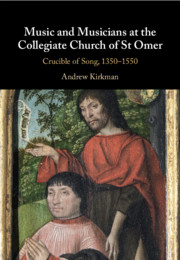Book contents
- Music and Musicians at the Collegiate Church of St Omer
- Frontispiece
- Music and Musicians at the Collegiate Church of St Omer
- Copyright page
- Epigraph
- Contents
- Figures and Map
- Acknowledgements
- Note on Editorial Policy, Currency and Dates
- Prologue
- 1 The Maîtrise
- 2 Identities and Career Patterns
- 3 Masters and Master Singers
- 4 The Organs
- 5 The Bells
- 6 Loose Canons? Music and the Craft of Ecclesiastical Power
- Epilogue
- Appendix Documents Pertaining to the Suppression of Benefices for the Upkeep of the Master and Choirboys (See )
- Bibliography
- Index
2 - Identities and Career Patterns
Published online by Cambridge University Press: 31 August 2020
- Music and Musicians at the Collegiate Church of St Omer
- Frontispiece
- Music and Musicians at the Collegiate Church of St Omer
- Copyright page
- Epigraph
- Contents
- Figures and Map
- Acknowledgements
- Note on Editorial Policy, Currency and Dates
- Prologue
- 1 The Maîtrise
- 2 Identities and Career Patterns
- 3 Masters and Master Singers
- 4 The Organs
- 5 The Bells
- 6 Loose Canons? Music and the Craft of Ecclesiastical Power
- Epilogue
- Appendix Documents Pertaining to the Suppression of Benefices for the Upkeep of the Master and Choirboys (See )
- Bibliography
- Index
Summary
This chapter addresses the backgrounds of choirboys of the era and the support network offered by their mother church. Their progress through the ranks, including the peculiarly St-Omer rank of ‘escotier’ aimed at maturing choirboys of limited means, leads the reader through to achievement of their training as vicars, chaplains, masters of the boys and, in a few significant cases, endowed canonries and even the lofty position of cantor. As elsewhere, musical skill could lead to high achievement. Patronage through university training was also an expected part of career support. The highest, or at least most noticeable, talent could lead to impressment into the choirs of the ruling dynasty, in this case that of Burgundy-Habsburg, and glittering careers. The role of direct patronage in such cases of the Habsburgs Mary of Hungary and Charles V is illustrated via the cases of individual St-Omer boys.
Keywords
- Type
- Chapter
- Information
- Music and Musicians at the Collegiate Church of St OmerCrucible of Song, 1350–1550, pp. 66 - 95Publisher: Cambridge University PressPrint publication year: 2020

